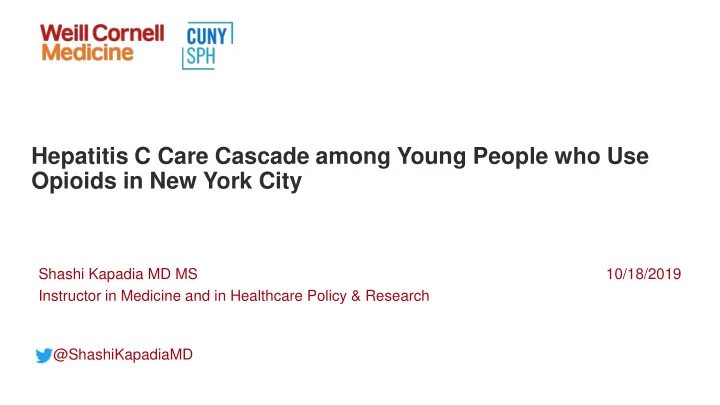

Hepatitis C Care Cascade among Young People who Use Opioids in New York City Shashi Kapadia MD MS 10/18/2019 Instructor in Medicine and in Healthcare Policy & Research @ShashiKapadiaMD 1
Disclosures Drs Kapadia and Eckhardt are co-investigators on research grants paid to our institutions from Gilead Sciences Inc, which manufactures hepatitis C medications. 2
Hepatitis C (HCV) incidence is rising in young people who inject drugs (PWID) NYC DOH Hepatitis B and C Annual Reports, 2016 and 2017 3
HCV can be eliminated, but faces implementation barriers in young PWID Favors HCV elimination: Hinders HCV elimination: Simple, effective treatments since 2014 Disease is perceived as non-urgent Increasing awareness among patients Stigma in healthcare settings prevents and providers about drug use and HCV disclosure and access Medicaid expansion provides insurance Prior authorization requirements access to many PWID discourage treating for new infections 4
We analyzed HCV testing patterns and care cascade from a sample of people who use drugs ages 18-29 in New York City 5
Study design and sampling • Design: Cross-sectional study • Population: People aged 18-29 years who lived in New York City and reported any heroin or nonmedical prescription opioid use 3 or more times in the past 30 days • Time-frame: Conducted from 2014 to 2016 • Sampling: Respondent driven sampling o 20 “seeds” who initiated recruitment chains 6
Recruitment chains Injecting (HCV -) Injecting (HCV+) Non-Injecting 7
Data collected: • HCV Antibody testing performed on all respondents • Socio-demographics and Drug Use Behavior • Previous Receipt of HCV Services: o Aware of diagnosis o Medical visit for HCV o Initiated Treatment o Completed Treatment • Barriers to HCV Testing 8
Statistical analyses presented today: • For people who are injecting (PWID) and who are non-injecting (non-PWID) o Descriptive Statistics on HCV testing • For people who are injecting (PWID): o Factors associated with HCV testing using logistic regression o Perceived barriers to HCV testing o Prevalence estimate for HCV antibody using RDS-sampling weights o Care cascade for testing and treatment 9
Sample characteristics Injecting Non-Injecting (n = 353) (n = 186) Median Age 25 (18-29) 23 (18-29) (Range) Male Gender 230 (65%) 135 (73%) Race/Ethnicity* Hispanic 66 (19%) 88 (47%) NH-White 259 (73%) 73 (39%) NH-Black 5 (1%) 17 (9%) NH-Other 22 (6%) 6 (3%) 10
Sample characteristics Injecting Non-Injecting (n = 353) (n = 186) Born in US 295 (84%) 160 (86%) Of non US-born PWID: 47 in Eastern Europe Currently Homeless 127 (36%) 10 (5%) 4 in Latin America Median # of years 3 (1-6) - 2 each in Asia, Middle injecting (IQR) East, Western Europe Ever used Syringe 193 (55%) 3 (2%) Exchange Ever in drug use 301 (85%) 83 (45%) treatment 11
A note on HCV testing Two-step diagnosis: RNA testing Antibody (Ab) testing Represents a current Does not distinguish infection. current infection from past (cleared or treated) But harder to field because of venipuncture Easier to field because of and cost point-of-care option 12
Hepatitis C Testing (injecting and non-injecting) Injecting Non- p* (n = 353) Injecting (n = 186) Ever Tested for HCV? 283 (80%) 86 (46%) <0.001 Tested for HCV in past-year? 279 (79%) 84 (45%) <0.001 Number of times tested?** (median and IQR) 3 (2-5) 2 (1-5) 0.04 *Chi-sq testing for ever tested, and Wilcoxon-Rank Sum for continuous **among 283 injecting and 86 non-injecting who were ever tested 13
Factors associated with receiving an HCV test for PWID aOR (95% CI) P-value # Years since first injection 1.16 (1.02-1.32) 0.02 Ever in substance use 3.17 (1.53-6.61) 0.002 treatment Used syringe exchange 1.86 (0.92-3.73) 0.08 US Born 2.06 (1.06-1.32) 0.05 Adjusted for age, gender, race, housing and prescription opioid injection (all nonsignificant). Education, income, and health insurance were nonsignificant in bivariate testing and not included in the multivariate model. 14
Perceived barriers to HCV testing for PWID who had never been tested (n = 69) "Don’t think you are at risk" 40% "Afraid of finding out" 19% "No time to get testing" 14% "Afraid of losing job, insurance, or 11% housing" 0% 5% 10% 15% 20% 25% 30% 35% 40% 45% 50% 15
105 of 353 PWID tested HCV Ab +: Estimated prevalence of HCV Ab in PWID is 25% after adjusting for RDS sampling weights None of the 186 people who did not inject tested HCV Ab + 16
Care cascade for HCV in PWID 100 353 90 Percent of participants 80 283 70 60 50 40 30 105 20 75 10 40 21 14 0 All PWID HCV Tested HCV Aware of Linked to Initiated Finished Antibody Diagnosis Care Treatment Treatment Positive 17
Limitations • Reliance on self-report for diagnosis, linkage and treatment data • Respondent driven sampling design may introduce selection bias • Early in direct acting antiviral era – may be rapidly changing • NY Medicaid with few restrictions on treatment – may not apply to all states 18
Conclusions • Substantial gaps to HCV testing and treatment among young people • Subset of people who immigrated from Eastern Europe with lower testing uptake • Non-injecting people have lower testing uptake and HCV prevalence • Need strategies to start testing earlier in people’s injecting careers • Need low-threshold and stigma-free models to deliver care to young PWID 19
Acknowledgments • Study participants for sharing their lived experience • Co-authors at CUNY-SPH and New York University Pedro Mateu-Gelabert (PI), Honoria Guarino (PI), Chunki Fong, Caroline Katzman, Benjamin Eckhardt • Funding Agencies: National Institute on Drug Abuse (R01 DA035146, K01 DA048172) National Institute of Mental Health (T32 MH073553) @ShashiKapadiaMD 20
Recommend
More recommend